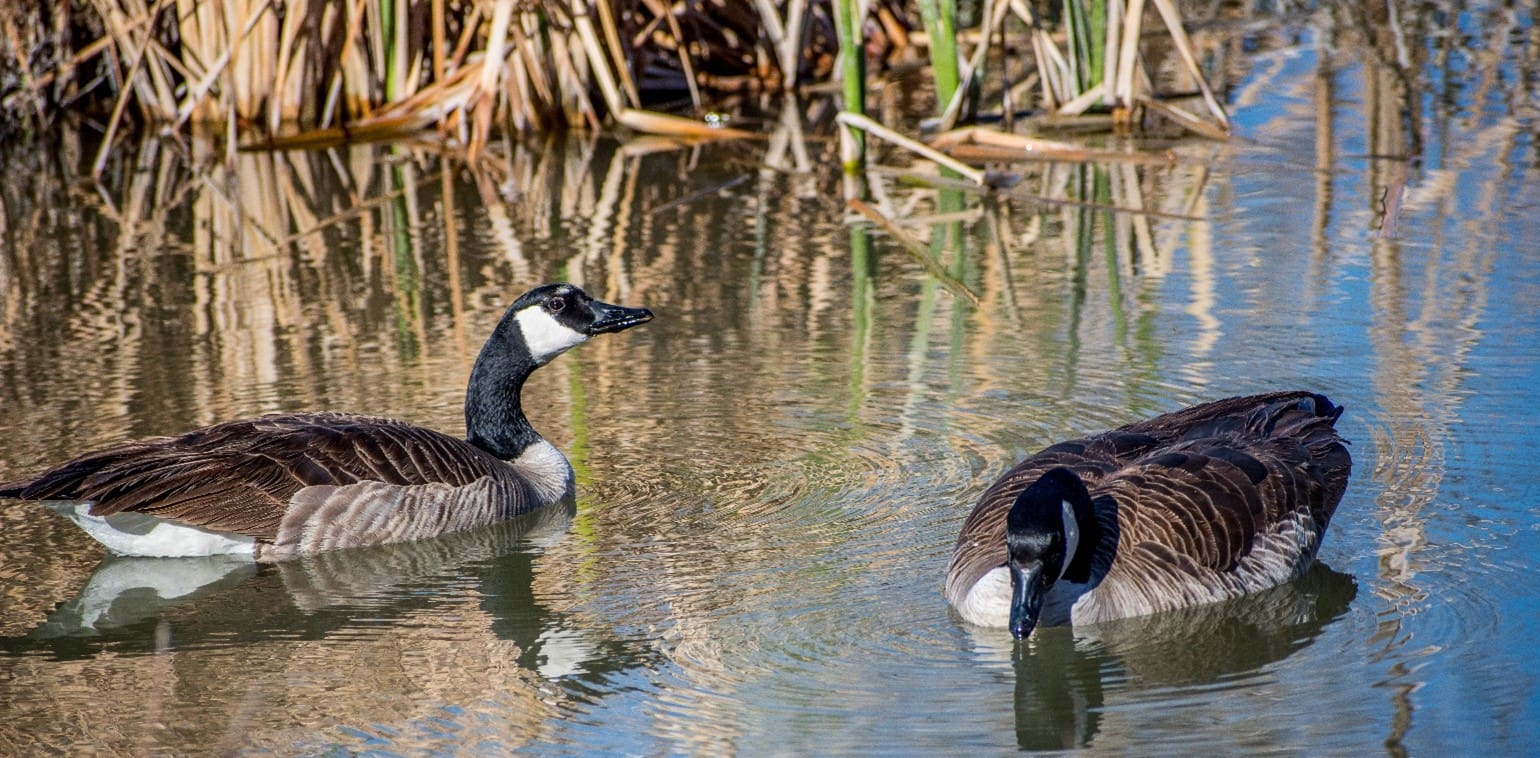The Canada Goose

WHAT WETLANDS pARK RESIDENT STRUCTURES ITS EXISTENCE AROUND FAMILY LIFE?
“Honk! Honk-Hink-Honk! Honk-honk!” On my early morning walks in our Green Valley neighborhood, I generally hear a sunrise commuter flight of Canada Geese (Branta canadensis) long before I see them. It may be one pair of geese, or a flock of ten to sixteen flying in their perfect “V” formation. Sometimes they are high overhead and sometimes flying at second-story window level, so I can see their black legs and feet tucked back against their light bodies. Sometimes one rolls its dark eye downward, watching the flightless creature on the sidewalk below (me!) as it sweeps by. No matter how many times I watch, I am always amazed that the geese can “chat” with each other nonstop while flying at 40 miles (or more) an hour.
It is difficult, anywhere in the animal kingdom, to beat Canada Geese for pair bond strength, family ties, and organization. While some young adults choose mates in their second year of life, most do so by their third year. Though males and females are similar in appearance, the males are larger and tend to stand “taller” in their role as sentry and defender. The male is called a gander; the smaller female is called a goose.
Once a goose and a gander mate, their bond is for life, which is ten to 25 years in the wild. Unlike other waterfowl, mated geese stay together year-round, not just in mating and nesting season. It’s been said that when a hunter kills a goose flying in its flock, its mate will circle back toward the fallen bird, calling plaintively. The birds’ mating instincts are strong: surviving partners will often seek new mates should they find themselves single.
Family bonds are also exceptional. Young geese stay with their parents and siblings most of their first year and sometimes well into their second. If they try to mate in their second year and the pairing fails, they just return to their family and try again later.
Families of Canada Geese combine to make up flocks. A small flock may contain just one goose family. Larger flocks will include some single geese and some mated pairs, but the larger the family, the more status it holds within the flock. Families are easy to see when a flock is landing, because single geese veer off to land solo, pairs land near each other, and family members all touch down very close to each other.
The goose is the nest-builder in the family. She constructs a nest of dry grass, shrubs, moss, sticks, and aquatic vegetation usually close to the water. Just before she begins to incubate her eggs, she tops the nest off with feathers and down plucked from her belly. While incubating, she leaves the nest several times a day for short breaks to eat, bathe, and drink, covering the eggs with a layer of the down before she leaves them.
The gander is the family guardian. He spends the incubation period on watch near the nest and accompanies the goose on her breaks. He is a truly ferocious protector, attacking intruders (including unwary people) with blows from his wings and stabs of his hard, serrated bill, all the while hissing and honking furiously.
Canada goose babies (called goslings) are precocial, emerging from their eggshells with eyes open, fully feathered in fine down, and able to walk, swim (including underwater dives of 30-40 feet), and feed themselves within hours of hatching. They immediately form a strong attachment with their parents and follow them wherever they go in a process called “imprinting.” It is critical for the young birds to recognize their parents, who will protect them from danger and lead them to good feeding areas. Shortly after they hatch, their parents lead them down to the water for the first time. One parent takes the lead and the other “rides drag” on the goslings between to prevent straggling. When the young geese are two to three months old, the parents teach them to fly in preparation for fall migration. When migration time comes, the family leaves together on their journey, covering as much as 1,500 miles a day. That said, with the proliferation of reliable and favorable habitat in our area, namely lawns, golf courses, and parks, you’ll notice that some Canada Geesestay year-round instead of migrating.
Any time of year, but mostly in spring and summer, try sneaking up (but not too close) on Clark County Wetlands Park’s resident Canada Geese to watch them feeding on vegetation and small aquatic animals in the ponds or onshore. Observe as they relax on the quiet water. And listen for that characteristic “Honk-Honk-Honk” overhead: the geese are almost sure to announce themselves as they fly!
– By Chris Leavitt, President; photo by Don Gibe
Please enjoy these YouTube videos:
Canada Goose facts: that honking v shape in the sky
Call of Canada Goose–Habitats And Migrations–Amazing Close Up Shots
Osprey & Canada Goose/Rogers Place Nest Camera powered by Explore.org (LIVECAM)
